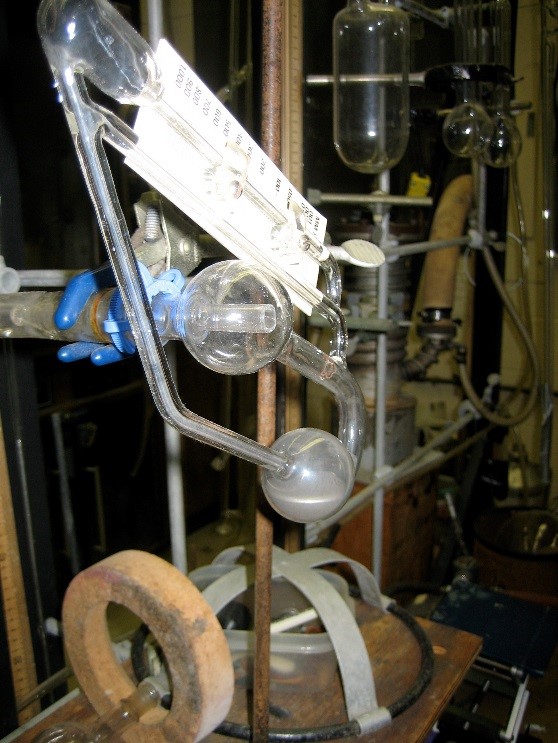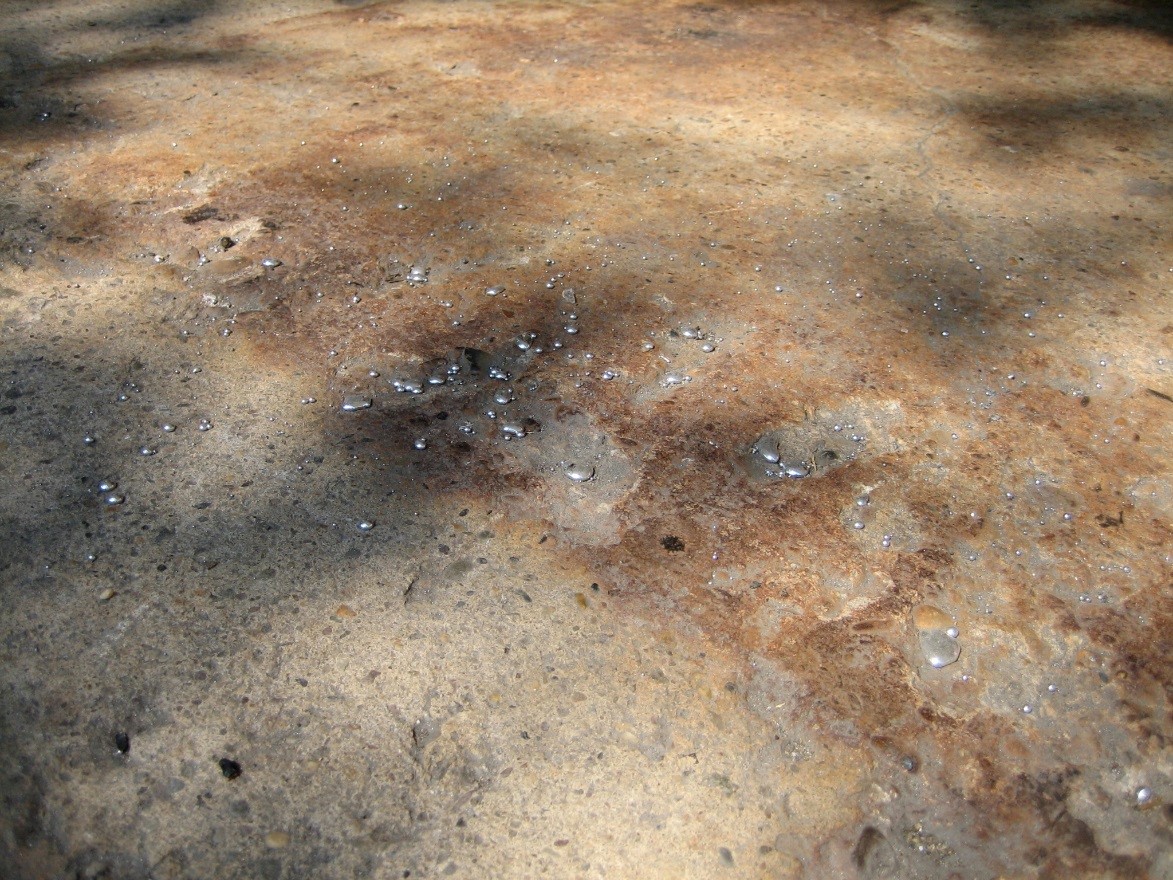Last Revised: April 12, 2024
Revision 4/2018
The requirements in Penn's Chemical Hygiene Plan SOP: Acutely Toxic Chemicals apply to all work involving mercury. The Fact Sheet below gives hazard information and precautions for working with this chemical; however, this information is provided as a supplement to the SOPs, which must first be read and understood by anyone planning to work with this chemical.
This fact sheet refers to elemental mercury. Other forms of mercury such as organic mercury and inorganic mercury salts have unique hazards and require controls other than those detailed here. If you are working with other forms of mercury, contact EHRS for assistance in conducting a hazard assessment.
Hazard Description
Elemental mercury is also known as colloidal mercury, metallic mercury, and quicksilver.
Mercury is often found in thermometers, thermostat switches, and manometers. It can be oxidized for use in various chemical reactions.
Elemental Mercury, CAS # 7439-97-6, is a very dense liquid metal with a low vapor pressure; however, due to mercury’s very high toxicity, the concentration of mercury vapor in equilibrium with air at room temperature can be hazardous by inhalation after only a few minutes of exposure. The amount of vapor formed increases with increased temperature.
Spills of elemental mercury often disperse into very small particles that have the potential to form vapor faster than the ventilation system can dilute it.
Mercury vapor is colorless and odorless. The primary route of entry is inhalation but mercury can also be readily absorbed through the skin.
Mercury is considered a neurotoxin. Once inhaled or absorbed, the mercury may have toxic effects on the central nervous system.
Signs of elemental-mercury exposure include:
- Emotional changes such as mood swings, nervousness, and irritability
- insomnia
- headache
- abnormal sensations and muscle twitching
- tremors
- weakness
- muscle atrophy
- decreased cognitive functions.
High exposures of elemental mercury can cause kidney malfunction, respiratory failure, and death
Approvals
All work that involves the handling or transfer of elemental mercury requires the approval of the P.I. The P.I. must ensure that the person or team who will be working with mercury understands the hazards and has received adequate training and supervision for the procedure.
For any task that requires safety controls beyond those specified in this SOP, a task-specific Hazard Control Plan (HCP) must be written. The HCP must be sent to EHRS for review. EHRS will upload the HCP to the “documents” section of the lab’s BioRAFT page.
Training Requirements
See Training Requirements section of SOP: Acutely Toxic Chemicals
Facility Requirements
See Facility Requirements section of SOP: Acutely Toxic Chemicals.
Signage and Labeling
See Signage and Labeling section of SOP: Acutely Toxic Chemicals.
Storage and Transport
All containers of mercury must be tightly sealed and stored in secondary containment. Mercury must be transported using a secondary container.
See Section VI: Chemical Storage and Transportation in this CHP for a complete list of requirements.
Hazard Controls
Engineering Controls
Mercury bubblers and other mercury-containing apparatus must be kept inside secondary containment to prevent the spread of mercury in the event of a spill.

(Mercury bubblers or manometers must be used only when less-hazardous alternatives are not possible.)
Chemical Fume Hood
All work with mercury in open or closed systems must be done in a designated area of a laboratory inside of a properly functioning chemical fume hood.
The fume hood is designed to capture chemical vapor and the hood sash acts as a shield in case of chemical splash. The sash must be kept closed as much as feasible.
Vacuum Protection
Mechanical vacuum pumps must be protected using traps and, where appropriate, must include a filter to prevent particulate release. The pump exhaust must be vented into an approved exhaust duct or chemical fume hood.
Work Practices
Considerations for work space
- When working with mercury, do not use equipment made of metals susceptible to amalgamation (e.g., copper, brass, zinc, tin, silver, lead, and gold) including equipment with soldered and brazed joints.
Considerations for handling
- Do not use mercury if less-hazardous alternatives are possible.
- Do not handle mercury when working alone.
- Immediately close all containers of mercury after use.
- Use good housekeeping practices to avoid contamination of surfaces, garments, personal belongings, and self.
- Do not dispense mercury directly onto a laboratory balance in the general lab space. Instead, transfer the material into a sealable pre-tared container inside the fume hood; then take the sealed container to the balance. Adjust the amount of material inside the container until the desired mass is reached. Make all adjustments inside the fume hood.
- Never place mercury thermometers in an oven. The temperature of the oven can exceed the upper measurement range of the thermometer, causing it to break and release mercury vapor.
Additional work practices for reducing the risks of any lab procedure involving mercury must be described in a written Hazard Control Plan.
Personal Protective Equipment
The minimum PPE requirements for all chemical handling tasks, and information about specialty PPE can be found in the Personal Protective Equipment section of Section V: Chemical Handling in this CHP.
Standard laboratory apparel including a fully-buttoned lab coat, long pants and closed-toe shoes must be worn when working with mercury.
Mercury is absorbed through the skin. Wear 4 mil nitrile gloves, which are sufficient to protect hands from incidental contact. Contaminated gloves must be removed and discarded properly. Contact EHRS for assistance with appropriate glove selection if prolonged contact with elemental mercury is anticipated.
In addition to the minimum lab apparel and PPE requirements, other protective equipment may be necessary to reduce risks. When additional equipment (such as tight-fitting chemical splash goggles, chemical-resistant gloves, or disposable lab coats) are required, a Hazard Control Plan must be written to document the risk assessment and controls.
Contact EHRS for assistance with risk assessments, glove compatibility, and other PPE selection.
Safety glasses complying with ANSI Z87 standards or chemical splash goggles must be worn.
Waste and Decontamination
For complete hazardous waste guidelines, see: Laboratory Chemical Waste Management Guidelines.
Wash hands thoroughly with soap and water after handling any chemical and whenever you leave the lab.
Decontaminate all surfaces that have come in contact with mercury.
See the chemical Safety Data Sheet or contact EHRS for assistance with determining an appropriate decontamination method. See “Spills” below for instruction on what to do in the event of a mercury spill.
Disposable labware that has come in contact with mercury must be collected in leak-proof disposable containers, labeled according to the Laboratory Chemical Waste Management Guidelines. and stored in secondary containment.
EHRS offers a program that will exchange mercury thermometers with environmentally friendly ones. Request your free replacement thermometer by filling out a Non-Mercury Thermometer Request Form.
Emergencies
Emergency Contacts
General emergency response information can be found at Emergency Info
Spills
Mercury has a high propensity for dispersing on a surface, so take great caution not to step in or spread the spill. For small spills (the amount from a mercury thermometer) use a mercury clean up kit if one is available, or contact EHRS for cleanup assistance. There are mercury spill kits available for purchase through Penn Marketplace vendors such as the Spilfyter Mercury Spill Kit from Fisher. For larger spills (such as the one shown below) evacuate the contaminated area and contact EHRS.
General procedures for chemicals spill response can be found in Section X: Chemical Spills in this CHP.
Do not hesitate to call EHRS for assistance with mercury spill clean-up.
24 hours: 215-898-4453
Contact Penn Police (511) only if the spill involves a fire, imminent risk of fire, an injury requiring an ambulance, or if there is a hazard that may affect others in the building.
EHRS must be called for response to large mercury spills.

References
This SOP was based on the document “EHRS Safety Fact Sheet for Mercury” and the following additional resources:
National Research Council. 2011. Prudent Practices in the Laboratory: Handling and Management of Chemical Hazards, Updated Version. Washington, DC: The National Academies Press. https://doi.org/10.17226/12654.